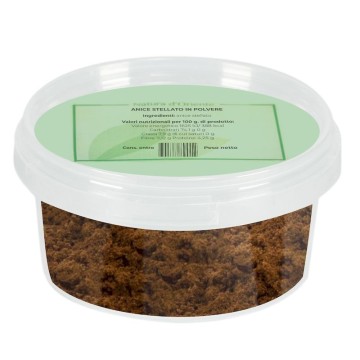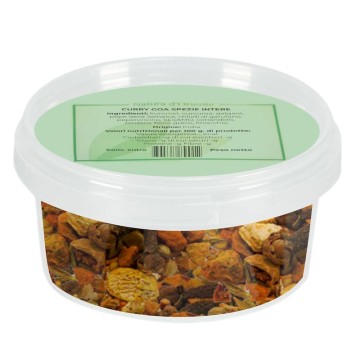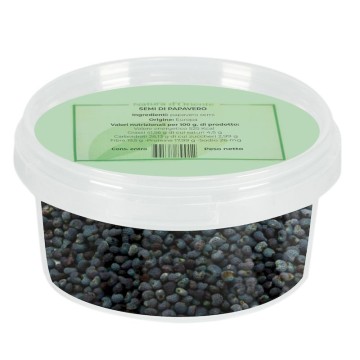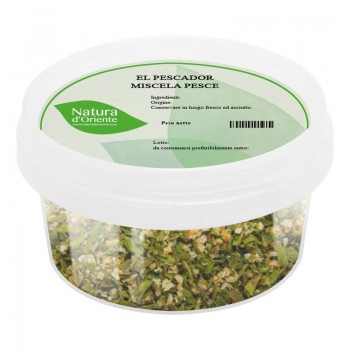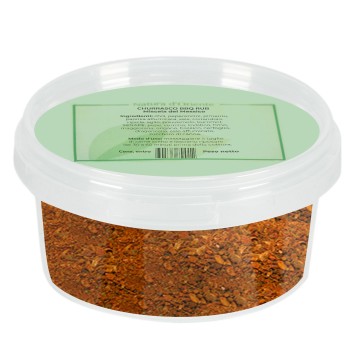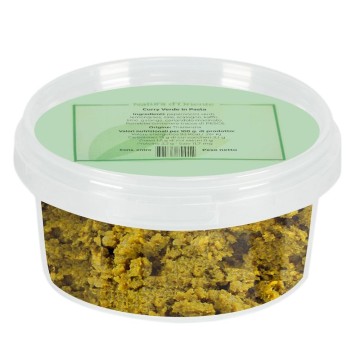Ethiopian cuisine is highly aromatic, with spices playing a prominent role, with dominant flavors often including fenugreek and ajowan. Food and drink are often flavored with one or more spices, herbs, and blends such as this Ethiopian curry. This particular blend of spices is found in the most popular dishes in Ethiopia and the surrounding area. Among these, Ethiopian curry flavors Ye Mesir azifa, wots (Ethiopian stews), teff cakes and biscuits, Ye assa Wath (cod), Khibé, Selatha, Azifa be Khariya, meat dishes such as Tibs and Dulet. It is a blend that has also had great success in the rest of the world, even more than Masala and Tandoori, due to its sweeter and lighter nature. In addition to its taste, Ethiopian curry is useful for improving the digestive phase, with good properties against irritation and the formation of excess gas. It is a blend of spices with antioxidant properties, which also helps regulate metabolism and stimulates blood circulation. Thanks to its intense aroma, it can help eliminate salt from some recipes, benefiting those who want to reduce sodium intake.
The spices contained in Ethiopian Curry
This spicy blend typical of the Horn of Africa combines 12 elements, creating a complex flavor and an intense aroma, while being delicate and light.
Cardamom gives the curry a fresh and balsamic aroma, reminiscent of honey and eucalyptus. The flavor is pungent but harmonious.
Turmeric adds a warm, slightly spicy flavor with bitter notes; an intense and exotic aroma.
Ajowan or Ethiopian cumin is a spice that intensifies the flavor in a decisive, slightly spicy sense; it hides a particular sweet-bitter aftertaste and is reminiscent of thyme.
Fenugreek creates a pungent, slightly bitter note in the mixture, with a scent reminiscent of fresh hay - much appreciated for flavoring meat and fish.
Ginger infuses a unique and refreshing pungent and spicy taste, as well as a smell that evokes lemon.
Garlic gives a strong and intense flavor of tingling on the palate, and a strong aroma that harmonizes with other more delicate spices.
The spicy and decisive note of the chili pepper creates a pungent stimulus to the mixture; it gives an intense and persistent fragrance.
Cinnamon adds a particular taste to the Ethiopian curry, between pungent and sweetish, spreading an aroma with peppery notes.
Paprika is the smoky, slightly spicy element, with a hint of bitterness that enhances meats.
Basil provides a sweet, peppery flavor, with hints of anise for a touch of freshness; nuances that enhance white meats and fish.
Thyme is known for creating a round, intense flavor in meat dishes, and adding depth to land-based recipes.
Lippia abyssinica (koseret) is an herb with a slightly minty flavor and a strong lemony note. Used in Ethiopian spiced butter, it enhances the flavor of sauces and stews.
Using Ethiopian Curry in Cooking
This blend of ground spices pairs well with many typical Ethiopian and Eritrean dishes, but it is suitable for many meat, rice and fish dishes. The powdered version is practical for adding to recipes during cooking or as a finishing touch; excellent in sauces and other elements such as in sautéing oil, clarified butter, yogurt or coconut milk. It can be used to sauté vegetables and meat in the pan, in typical dishes. Its color gives it a particular intense yellow color, appreciated on rice.
Meat and fish: it goes well with red and white meat such as chicken, beef, lamb, goat, game, rabbit and pork. Ethiopian curry is widely used in the variety of "wat" stews, in fish recipes and in seafood dishes. In Western cuisine this curry can be used in the preparation of rubs for BBQ meat, for grilling and roasting - carefully evaluating its delicate character.
Savory recipes: Ethiopian curry goes well with rice, vegetables, legumes, hard-boiled eggs. In our cuisine it can be a useful mix for soups, broths and broths, potatoes and baked goods. It can be used to add an exotic touch and a complex aroma to creative recipes.
Sauces: This curry mix becomes a spicy element for vegetable sauces or to use on meats, rice and fish. It can be used to enhance the aroma of gravies and dressings, for spreads, sauces with yogurt or sour cream.
Sweet recipes: Some recipes use these spices together with teff (a gluten-free grain typical of Ethiopia and Eritrea) for biscuits and cakes. In addition, the mild curry pairs well with
yogurt.
Chicken breast with Ethiopian curry
Ingredients: 450 g chicken breast cut into 4 cm cubes - 2 tablespoons Ethiopian curry powder - 1 teaspoon chili powder - 2 tablespoons whole yogurt - 150 g chopped white onion - 80 g olive oil - 50 g diced tomatoes - 1 teaspoon garlic and ginger paste (can be replaced with fresh chopped garlic and ginger) - 350 g water - 80 g thick coconut milk
Preparation
Cut the chicken into cubes and place in a bowl. Season with yogurt, curry and chili powder (dosing according to the desired intensity). Leave to marinate for 15 minutes. Chop the onions and place them in a pan with the oil. Let them wilt and then brown slightly, without burning them. Add the tomato (optional), the ginger-garlic paste, the chicken with all the marinade and cover with water. Let it simmer until the chicken is cooked, about 10 minutes. Add the coconut milk, season with salt and let it cook until the cooking juices thicken slightly. The dish will be even more flavorful if you let it rest and serve it warm.
Origins and History of Ethiopian Curry
Ethiopia has unique cultural inclinations even in the cuisine, and the love of Ethiopians for spices stands out. Almost all the food and drinks consumed daily are spiced or flavored with aromatic herbs. This tradition comes from particular spices of the territory, some even little known still - they are not commonly found throughout the world. The various spices, herbs and roots used are mostly endemic to Ethiopia or neighboring territories, but in recent times they have also spread to other continents. Many Ethiopians live abroad, which is why both the export of spices and the experimentation in the kitchen in mixtures, such as Ethiopian curry, are growing. The word "curry" however comes from the Indian tradition combined with the English one, and today it means both the name of many typical Indian dishes and the seasoning in powdered spices, to make it. In the English tradition the use of "curry" spices was brought by merchants and agents of the East India Company in the 18th century. Curry powder was a very fragrant Indian mixture of spices, which over time can count on many different formulas and dozens of ingredients - even if usually cumin, mustard, chili pepper, black pepper, coriander, turmeric root are never missing. Curry mixes were often golden in color due to the turmeric, with the aroma divided into three different intensities of spiciness: mild, hot, very hot. Today, very different versions of curry are available on the market. From the prized Garam masala (for meat and vegetables) to the red Tandoori mix (for marinating meat with yogurt, cooked in the tandoor oven), up to spicy mixes such as Madras curry or Vindaloo curry, suitable for the sweet and sour specialties of the Goa region.



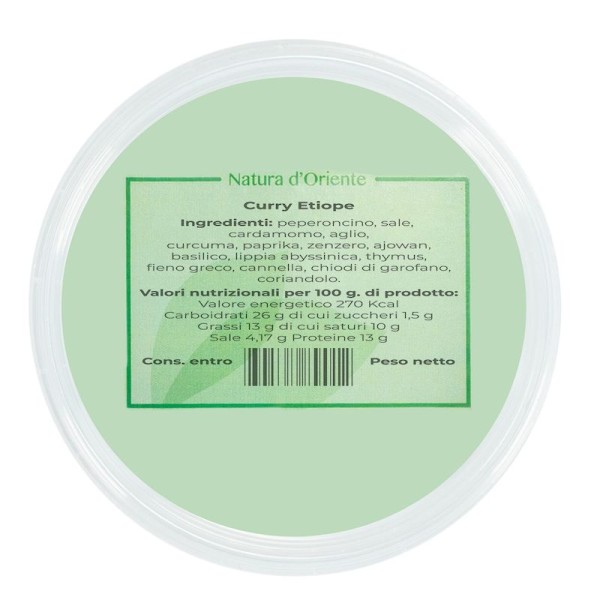







 No reward points for this product.
No reward points for this product.
